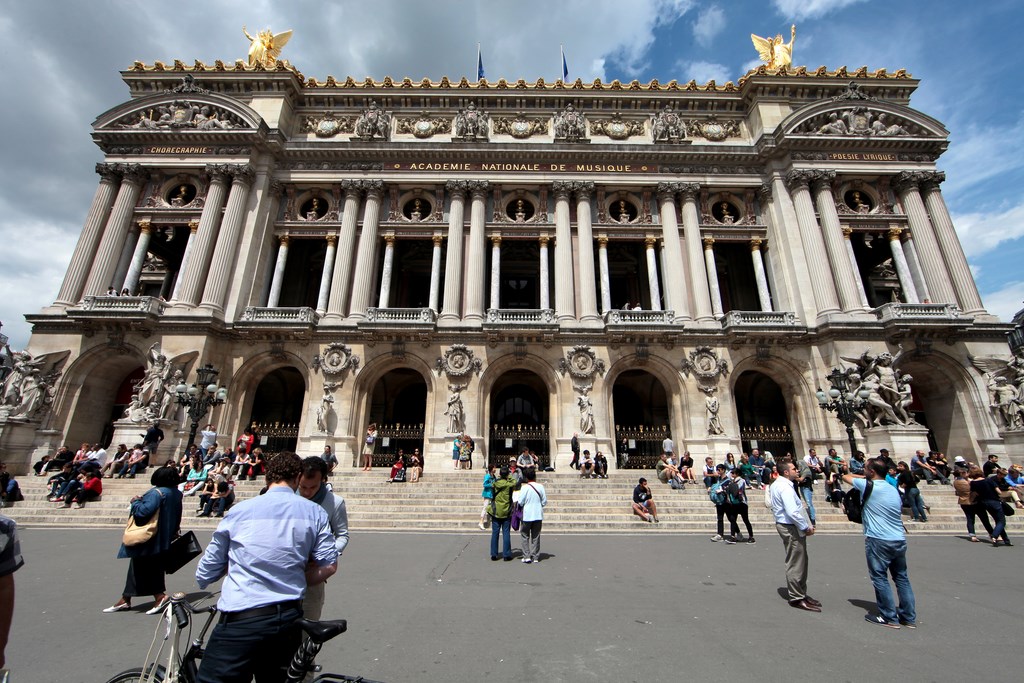OPERA GARNIER
L’Opéra Garnier, ou Palais Garnier, est un des édifices structurants du 9e arrondissement de Paris et du paysage de la capitale française. Situé à l'extrémité de l'avenue de l'Opéra, près de la station de métro du même nom, l'édifice s'impose comme un monument particulièrement représentatif de l'architecture éclectique et du style historiciste de la seconde moitié du XIXe siècle et s'inscrit dans la continuité des transformations de Paris menées à bien par Napoléon III et le préfet Haussmann.
Cette construction a longtemps été appelée l'«Opéra de Paris», mais depuis l'ouverture de l'Opéra Bastille en 1989, on la désigne par le seul nom de son auteur : Charles Garnier. Les deux sites sont aujourd'hui regroupés au sein de l'établissement public, industriel et commercial de l'«Opéra de Paris».
Le Palais Garnier fait l’objet d’un classement au titre des monuments historiques depuis le 16 octobre 19231.
----------------------------------------------
The Palais Garnier is a 1,979-seat opera house, which was built from 1861 to 1875 for the Paris Opera. It was originally called the Salle des Capucines because of its location on the Boulevard des Capucines in the 9th arrondissement of Paris, but soon became known as the Palais Garnier in recognition of its opulence and its architect, Charles Garnier. The theatre is also often referred to as the Opéra Garnier, and historically was known as the Opéra de Paris or simply the Opéra, as it was the primary home of the Paris Opera and its associated Paris Opera Ballet until 1989, when the Opéra Bastille opened at the Place de la Bastille. The Paris Opera now mainly uses the Palais Garnier for ballet.
The Palais Garnier is "probably the most famous opera house in the world, a symbol of Paris like Notre Dame Cathedral, the Louvre, or the Sacré Coeur Basilica." This is at least partly due to its use as the setting for Gaston Leroux's 1910 novel The Phantom of the Opera and, especially, the novel's subsequent adaptations in films and Andrew Lloyd Webber's popular 1986 musical.[9] Another contributing factor is that among the buildings constructed in Paris during the Second Empire, besides being the most expensive, it has been described as the only one that is "unquestionably a masterpiece of the first rank." This opinion is far from unanimous however: the 20th-century French architect Le Corbusier once described it as "a lying art" and contended that the "Garnier movement is a décor of the grave".
The Palais Garnier also houses the Bibliothèque-Musée de l'Opéra de Paris (Paris Opera Library-Museum). Although the Library-Museum is no longer managed by the Opera and is part of the Bibliothèque nationale de France, the museum is included in unaccompanied tours of the Palais Garnier.
Cette construction a longtemps été appelée l'«Opéra de Paris», mais depuis l'ouverture de l'Opéra Bastille en 1989, on la désigne par le seul nom de son auteur : Charles Garnier. Les deux sites sont aujourd'hui regroupés au sein de l'établissement public, industriel et commercial de l'«Opéra de Paris».
Le Palais Garnier fait l’objet d’un classement au titre des monuments historiques depuis le 16 octobre 19231.
----------------------------------------------
The Palais Garnier is a 1,979-seat opera house, which was built from 1861 to 1875 for the Paris Opera. It was originally called the Salle des Capucines because of its location on the Boulevard des Capucines in the 9th arrondissement of Paris, but soon became known as the Palais Garnier in recognition of its opulence and its architect, Charles Garnier. The theatre is also often referred to as the Opéra Garnier, and historically was known as the Opéra de Paris or simply the Opéra, as it was the primary home of the Paris Opera and its associated Paris Opera Ballet until 1989, when the Opéra Bastille opened at the Place de la Bastille. The Paris Opera now mainly uses the Palais Garnier for ballet.
The Palais Garnier is "probably the most famous opera house in the world, a symbol of Paris like Notre Dame Cathedral, the Louvre, or the Sacré Coeur Basilica." This is at least partly due to its use as the setting for Gaston Leroux's 1910 novel The Phantom of the Opera and, especially, the novel's subsequent adaptations in films and Andrew Lloyd Webber's popular 1986 musical.[9] Another contributing factor is that among the buildings constructed in Paris during the Second Empire, besides being the most expensive, it has been described as the only one that is "unquestionably a masterpiece of the first rank." This opinion is far from unanimous however: the 20th-century French architect Le Corbusier once described it as "a lying art" and contended that the "Garnier movement is a décor of the grave".
The Palais Garnier also houses the Bibliothèque-Musée de l'Opéra de Paris (Paris Opera Library-Museum). Although the Library-Museum is no longer managed by the Opera and is part of the Bibliothèque nationale de France, the museum is included in unaccompanied tours of the Palais Garnier.
